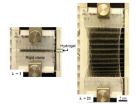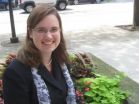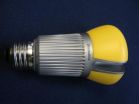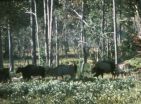(Press-News.org) Cambridge, Mass. - September 5, 2012 - A team of experts in mechanics, materials science, and tissue engineering at Harvard have created an extremely stretchy and tough gel that may pave the way to replacing damaged cartilage in human joints.
Called a hydrogel, because its main ingredient is water, the new material is a hybrid of two weak gels that combine to create something much stronger. Not only can this new gel stretch to 21 times its original length, but it is also exceptionally tough, self-healing, and biocompatible—a valuable collection of attributes that opens up new opportunities in medicine and tissue engineering.
The material, its properties, and a simple method of synthesis are described in the September 6 issue of Nature.
"Conventional hydrogels are very weak and brittle—imagine a spoon breaking through jelly," explains lead author Jeong-Yun Sun, a postdoctoral fellow at the Harvard School of Engineering and Applied Sciences (SEAS). "But because they are water-based and biocompatible, people would like to use them for some very challenging applications like artificial cartilage or spinal disks. For a gel to work in those settings, it has to be able to stretch and expand under compression and tension without breaking."
Sun and his coauthors were led by three faculty members: Zhigang Suo, Allen E. and Marilyn M. Puckett Professor of Mechanics and Materials at SEAS and a Kavli Scholar at the Kavli Institute for Bionano Science and Technology at Harvard; Joost J. Vlassak, Gordon McKay Professor of Materials Engineering and an Area Dean at SEAS; and David J. Mooney, Robert P. Pinkas Family Professor of Bioengineering at SEAS and a Core Faculty Member at the Wyss Institute for Biologically Inspired Engineering at Harvard.
To create the tough new hydrogel, they combined two common polymers. The primary component is polyacrylamide, known for its use in soft contact lenses and as the electrophoresis gel that separates DNA fragments in biology labs; the second component is alginate, a seaweed extract that is frequently used to thicken food.
Separately, these gels are both quite weak—alginate, for instance, can stretch to only 1.2 times its length before it breaks. Combined in an 8:1 ratio, however, the two polymers form a complex network of crosslinked chains that reinforce one another. The chemical structure of this network allows the molecules to pull apart very slightly over a large area instead of allowing the gel to crack.
The alginate portion of the gel consists of polymer chains that form weak ionic bonds with one another, capturing calcium ions (added to the water) in the process. When the gel is stretched, some of these bonds between chains break—or "unzip," as the researchers put it—releasing the calcium. As a result, the gel expands slightly, but the polymer chains themselves remain intact. Meanwhile, the polyacrylamide chains form a grid-like structure that bonds covalently (very tightly) with the alginate chains.
Therefore, if the gel acquires a tiny crack as it stretches, the polyacrylamide grid helps to spread the pulling force over a large area, tugging on the alginate's ionic bonds and unzipping them here and there. The research team showed that even with a huge crack, a critically large hole, the hybrid gel can still stretch to 17 times its initial length.
Importantly, the new hydrogel is capable of maintaining its elasticity and toughness over multiple stretches. Provided the gel has some time to relax between stretches, the ionic bonds between the alginate and the calcium can "re-zip," and the researchers have shown that this process can be accelerated by raising the ambient temperature.
The group's combined expertise in mechanics, materials science, and bioengineering enabled the group to apply two concepts from mechanics—crack bridging and energy dissipation—to a new problem.
"The unusually high stretchability and toughness of this gel, along with recovery, are exciting," says Suo. "Now that we've demonstrated that this is possible, we can use it as a model system for studying the mechanics of hydrogels further, and explore various applications."
"It's very promising," Suo adds.
Beyond artificial cartilage, the researchers suggest that the new hydrogel could be used in soft robotics, optics, artificial muscle, as a tough protective covering for wounds, or "any other place where we need hydrogels of high stretchability and high toughness."
INFORMATION:
Additional coauthors included Xuanhe Zhao, a former Ph.D. student and postdoc at SEAS, now a faculty member at Duke University; Widusha R. K. Illeperuma, a graduate student at SEAS; Ovijit Chaudhuri, a postdoc in Mooney's lab; and Kyu Hwan Oh, Sun's former adviser and a faculty member at Seoul National University in Korea.
This work was supported by the U.S. Army Research Office, the National Science Foundation (NSF), the Defense Advanced Research Projects Agency, the National Institutes of Health, and the NSF-funded Materials Research Science and Engineering Center (MRSEC) at Harvard. The researchers also individually received support from the NSF Research Triangle MRSEC, a Haythornthwaite Research Initiation grant, the National Research Foundation of Korea, an Alexander von Humboldt Award, and Harvard University.
Tough gel stretches to 21 times its length, recoils, and heals itself
Biocompatible material created at Harvard is much tougher than cartilage
2012-09-06
ELSE PRESS RELEASES FROM THIS DATE:
The ENCODE Project publishes new genomic insights in special issue of Genome Research
2012-09-06
Genome Research publishes online and in print today a special issue dedicated to The ENCODE (ENCyclopedia Of DNA Elements) Project, whose goal is to characterize all functional elements in the human genome. Since the completion of the pilot phase of the project in 2007, covering 1% of the genome, The ENCODE Consortium has fanned out across the genome to study function and regulation on an unprecedented scale. This special issue presents novel findings, methodologies, and resources from ENCODE that bring extensive insight to gene regulation and set the stage for future ...
BUSM/VA researchers examine new PTSD diagnosis criteria
2012-09-06
(Boston) – Results of a study led by researchers at Boston University School of Medicine (BUSM) and the Veterans Affairs (VA) Boston Healthcare System indicate that the proposed changes to the diagnosis of post-traumatic stress disorder (PTSD) will not substantially affect the number of people who meet criteria for the disorder.
Mark W. Miller, PhD, associate professor at BUSM and a clinical research psychologist at the National Center for PTSD at VA Boston Healthcare System served as lead author of the study, which is published online in Psychological Trauma: Theory, ...
Seeing the birth of the universe in an atom of hydrogen
2012-09-06
Windows to the past, stars can unveil the history of our universe, currently estimated to be 14 billion years old. The farther away the star, the older it is — and the oldest stars are the most difficult to detect. Current telescopes can only see galaxies about 700 million years old, and only when the galaxy is unusually large or as the result of a big event like a stellar explosion.
Now, an international team of scientists led by researchers at Tel Aviv University have developed a method for detecting galaxies of stars that formed when the universe was in its infancy, ...
Genome-wide scan maps mutations in deadly lung cancers; reveals embryonic gene link
2012-09-06
Scientists have completed a comprehensive map of genetic mutations linked to an aggressive and lethal type of lung cancer.
Among the errors found in small cell lung cancers, the team of scientists, including those at the Johns Hopkins Kimmel Cancer Center, found an alteration in a gene called SOX2 associated with early embryonic development.
"Small cell lung cancers are very aggressive. Most are found late, when the cancer has spread and typical survival is less than a year after diagnosis," says Charles Rudin, M.D., Ph.D., professor of oncology at the Johns Hopkins ...
Hospital-acquired UTIs rarely reported in data used to implement penalties
2012-09-06
ANN ARBOR, Mich. — Aiming to cut expenses and improve care, a 2008 Medicare policy stopped paying hospitals extra to treat some preventable, hospital-acquired conditions – including urinary tract infections (UTIs) in patients after bladder catheters are placed.
But a statewide analysis by the University of Michigan shows there was very little change in hospital payment due to removing pay for hospital-acquired catheter-associated UTIs. For all adult hospital stays in Michigan in 2009, eliminating payment for this infection decreased hospital pay for only 25 hospital ...
LEDs winning light race to save energy, the environment
2012-09-06
RICHLAND, Wash. – Today's light-emitting diode light bulbs have a slight environmental edge over compact fluorescent lamps. And that gap is expected to grow significantly as technology and manufacturing methods improve in the next five years, according to a new report from the Department of Energy's Pacific Northwest National Laboratory and UK-based N14 Energy Limited.
"The light-emitting diode lamp is a rapidly evolving technology that, while already energy efficient, will become even more so in just a few short years," said Marc Ledbetter, who manages PNNL's solid-state ...
Exceptional upward mobility in the US is a myth, international studies show
2012-09-06
ANN ARBOR, Mich.—The rhetoric is relentless: America is a place of unparalleled opportunity, where hard work and determination can propel a child out of humble beginnings into the White House, or at least a mansion on a hill.
But the reality is very different, according to a University of Michigan researcher who is studying inequality across generations around the world.
"Especially in the United States, people underestimate the extent to which your destiny is linked to your background. Research shows that it's really a myth that the U.S. is a land of exceptional social ...
Wildlife Conservation Society releases list of Asian species at the conservation crossroads
2012-09-06
JEJU, SOUTH KOREA (September 5, 2012) — Will the tiger go the way of the passenger pigeon or be saved from extinction like the American bison?
The Wildlife Conservation Society (WCS) today released a list of Asian species that are at a conservation crossroads calling for governments to take immediate action with The Three R's Approach: Recognition, Responsibility, Recovery.
The list includes: the tiger, orangutans, Mekong giant catfish, Asian rhinos, Asian giant river turtles, and Asian vultures. The announcement was made at the IUCN's World Conservation Congress convening ...
Guys, take note: Male birth control pill may be ready soon, says Texas A&M professor
2012-09-06
Attention men: The day may be coming soon when you can take your own birth control pill with no side effects, according to a study done by a group of scientists that includes a Texas A&M University researcher.
Qinglei Li, an assistant professor in Texas A&M's College of Veterinary Medicine & Biomedical Sciences, is part of a team of researchers led by Martin Matzuk at Baylor College of Medicine and James Bradner at Dana-Farber Cancer Institute who made the discovery, and their work is published in the journal Cell.
Working on mice, the team found that a compound called ...
Major advances in understanding the regulation and organization of the human genome
2012-09-06
The National Human Genome Research Institute today announced the results of a five-year international study of the regulation and organization of the human genome. The project is named ENCODE, which stands for the Encyclopedia of DNA Elements. In conjunction with the release of those results, the Journal of Biological Chemistry has published a series of reviews that focus on several aspects of the findings.
"The ENCODE project not only generated an enormous body of data about our genome, but it also analyzed many issues to better understand how the genome functions in ...
LAST 30 PRESS RELEASES:
Beech trees use seasonal soil moisture to optimize water uptake
How thinning benefits growth for all trees
Researchers upgrades 3-PG forest model for improved accuracy
Achieving anti-thermal-quenching in Tb3+-doped glass scintillators via dual-channel thermally enhanced energy transfer
Liquid metal modified hexagonal boron nitride flakes for efficient electromagnetic wave absorption and thermal management
Failure mechanisms in PEM water electrolyzers
Study captures how cancer cells hide from brain immune cells, shows that removing their “don’t eat me” signals stops their escape
New breakthrough in detecting ‘ghost particles’ from the Sun
Half of people arrested in London may have undiagnosed ADHD, study finds
From dots to lines: new database catalogs human gene types using ’ACTG’ rules
Persistent antibiotic resistance of cholera-causing bacteria in Africa revealed from a multinational workshop for strengthening disease surveillance
SwRI, Trinity University to synthesize novel compound to mitigate effects of stroke, heart attack
Novel endocrine therapy giredestrant improves disease-free survival over standard of care for patients with early-stage breast cancer in phase III lidERA trial
Gen Z views world as "scary place" with growing cynicism about ability to create change
Biosensor performance doubled – New applications possible
Leveraging incomplete remote sensing for forest inventory
Key chemical in dark chocolate may slow down ageing
New 15-minute hepatitis C test paves the way for same-day treatment
Uranus and Neptune might be rock giants
Magnetically actuated soft electrodes for multisite bioelectrical monitoring of ex vivo tissues
FAU engineers decode dementia type using AI and EEG brainwave analysis
Carrier-free peptide–daunorubicin–small interfering RNA nanoassembly for targeted therapy of acute myeloid leukemia
Global Virus Network announces appointment of new board members
Artificial beaver dams show promise in offsetting climate change effects
Could hidden infections be fueling long COVID?
Targeted oxygen for initial resuscitation of preterm infants
Researchers develop models to help diagnose ALS earlier through blood biomarkers
Jeonbuk National University researchers develop novel eco-friendly and photo-switchable smart adhesives
Magnetic ordering induces Jahn–Teller effect in spinel-type compounds
A mitochondrial protein may hold the secret to longevity, new study finds
[Press-News.org] Tough gel stretches to 21 times its length, recoils, and heals itselfBiocompatible material created at Harvard is much tougher than cartilage




